Related Research Articles

Boleslaus I, a member of the Přemyslid dynasty, was ruler of the Duchy of Bohemia from 935 until his death in 972. He is notorious for the murder of his elder brother Wenceslaus, through which he became duke.

The Duchy of Bohemia, also later referred to in English as the Czech Duchy, was a monarchy and a principality of the Holy Roman Empire in Central Europe during the Early and High Middle Ages. It was formed around 870 by Czechs as part of the Great Moravian realm. Bohemia separated from disintegrating Great Moravia after Duke Spytihněv swore fealty to the East Frankish king Arnulf in 895.

Boleslaus II the Pious, a member of the Přemyslid dynasty, was Duke of Bohemia from 972 until his death in 999.

Boleslaus III, called the Red or the Blind, a member of the Přemyslid dynasty, was Duke of Bohemia from 999 until 1002 and briefly again during the year 1003. During his chaotic reign, Bohemia became a pawn in the long German–Polish War between King Henry II and Duke Bolesław I, "the Brave", of Poland.

Jaromír, a member of the Přemyslid dynasty, was Duke of Bohemia in 1003, from 1004 to 1012, and again from 1034 to 1035.
Vladivoj was Duke of Bohemia from 1002 until his death.
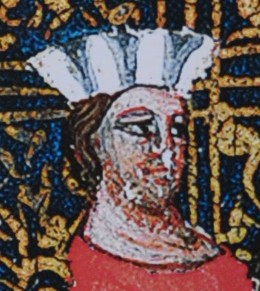
Oldřich, a member of the Přemyslid dynasty, was Duke of Bohemia from 1012 to 1033 and briefly again in 1034. His accession to the Bohemian throne marked the start of a phase of stability after a long period of internal dynastic struggles. Under his rule, the Moravian lands were reconquered from Polish occupation.
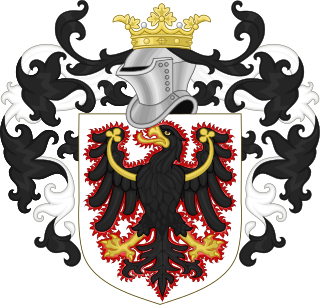
The Přemyslid dynasty or House of Přemysl was a Bohemian royal dynasty that reigned in the Duchy of Bohemia and later Kingdom of Bohemia and Margraviate of Moravia, as well as in parts of Poland, Hungary and Austria.

The Slavniks/Slavníks or Slavnikids was a dynasty in the Duchy of Bohemia during the 10th century. It is considered to be of White Croats origin. The center of the semi-independent principality was the gord of Libice located at the confluence of the rivers Cidlina and Elbe. The Slavníks competed with the Přemyslid dynasty for control over Bohemia and eventually succumbed to them.
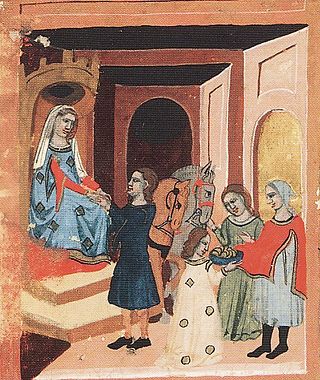
Drahomíra of Stodor was Duchess consort of Bohemia from 915 to 921, wife of the Přemyslid duke Vratislaus I. She also acted as regent of the Duchy of Bohemia from 921 to 924 during the minority of her son Wenceslaus. She is chiefly known for the murder of her mother-in-law Ludmila of Bohemia by hired assassins.
Kunigunda Rostislavna was Queen consort of Bohemia and its regent from 1278 until her death. She was a member of the House of Chernigov, and a daughter of Rostislav Mikhailovich.
Emma of Italy was Queen of Western Francia as the wife of King Lothair, whom she married in 965. Their son, Louis V, was the last Carolingian king.

Emma (Hemma) (bef. 950 – 1005/06) was a Bohemian duchess consort as the second wife of Boleslaus II of Bohemia.
Biagota was probably the wife of duke Boleslaus I of Bohemia.

Božena (Křesinová) was the second wife of Duke Oldřich of Bohemia and mother of Bretislaus I of Bohemia.
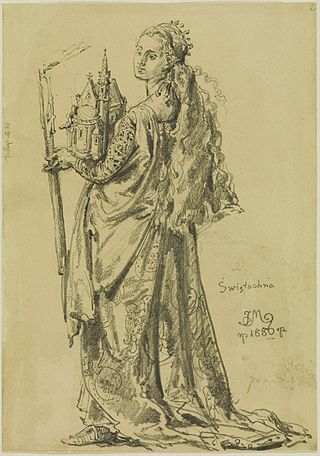
Świętosława of Poland was the third wife of Duke Vratislaus II of Bohemia and the first Queen of Bohemia as of 1085.

Kunigunde of Bohemia was the eldest daughter of Ottokar II of Bohemia and his second wife, Kunigunda of Slavonia. She was a member of the Přemyslid dynasty. She was Princess of Masovia by her marriage to Boleslaus II of Masovia and later became abbess of the St. George's Convent at Prague Castle.

Bolesław, Boleslaw, Boleslav or Boleslaus in Latin, is a male given name of Slavic origin meaning great glory. Feminine forms: Bolesława / Boleslava.
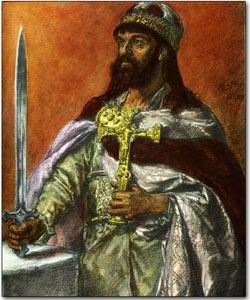
The Polish–Bohemian War or Polish–Czech War was a conflict in Europe in 990 between the Polish duke Mieszko I of the Duchy of Poland and the Bohemian duke Boleslaus II of the Duchy of Bohemia. It ended with the Bohemians' defeat and with Poland conquering the territory of Silesia.
References
- ↑ Časopis Národního musea: Oddíl věd společenských (in Czech). Museum. 1953.
- ↑ Bauer, Jan (2012-01-01). Ženy z rodu Přemyslovců (in Czech). Alpress. ISBN 978-80-7466-624-7.